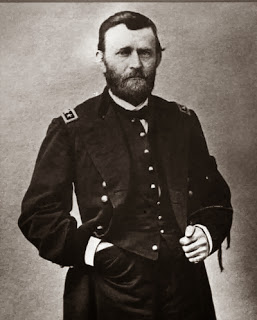How about Betsy Ross designing the first flag. This account of the creation of our first flag was first brought to light in 1870 by one of her grandsons, William J. Canby, at a meeting of the Historical Society of Pennsylvania. This took place 94 years after the event supposedly took place! Mr. Canby was a boy of eleven years when Mrs. Ross died in his home.
We all know the picture, but what is wrong with it. First of all, the supposedly took place in June 1776, when Washington asked Ms. Ross to design the flag. If you look, this flag has the traditional circle of 13 stars. Unfortunately, this flag design was only approved by the Continental Congress on June 14, 1777 (flag day). There is no historical evidence at all that discusses Ross and the flag. It seems that the story was concocted to draw attention to the Ross house in Philadelphia so that it could be made a historical monument.
What about Paul Revere’s Ride. In January 1861, Henry Wadsworth Longfellow published a poem about Revere’s ride. We all know it. “Listen my children and you shall hear...” Funny thing, but before that poem appeared, most Americans had never heard of Paul Revere except as a silversmith. Not a single mention of him appears in any compendium of Revolutionary figures before 1863. I checked myself in a book about the Revolution published in 1854. No Paul Revere at all. We do find mention of William Dawes, who actually made the ride. The poem, however, made Revere a national hero in the latter part of the 19th century. (Somewhere, I have a wonderful cartoon that I can’t find. It shows Longfellow sitting at his desk, thinking. “Listen my children and you shall hear of the midnight ride of William Dawes... William Dawes.” He turns to his wife and asks, “Dear, what was the name of that other fellow who rode that night?”
Speaking of Revere. His famous painting of the Boston Massacre is filled with inaccuracies, all on purpose. The painting was done to inflame Bostonians against the British, not to depict history. The British didn’t fire as a group. And Captain Preston was not in front directing fire. As came out in the trial at which John Adams got the British acquitted, Preston did not give an order to fire.
Is this the “little woman who wrote the book that made this great war.” So said Abraham Lincoln to Harriet Beecher Stowe when she visited the White House in 1863. Probably was never said. The earliest printed source for a similar version of the quote–“Is this the little woman who made the great war?”–appeared in the Atlantic Monthly version of Annie Fields’s biography, entitled “Days with Mrs. Stowe” and published in August 1896, nearly contemporaneous with Stowe’s death on 1 July. Lincoln scholars hesitate to validate the quote.
Lincoln stories are always great in lectures. When told that his General Ulysses Grant had a drinking problem Lincoln is reputed to have said, “If I knew what brand he used, I send every General a barrel.” A great quote, but he never said it. In fact, Lincoln denied ever saying it.
One of my favorite scenes from history is General John Pershing striding off the boat in France in 1917 and saying, “Lafayette, we are here.” So dramatic a line to tell the French we are repaying them for the American Revolution. He didn’t say it. One of his aides said it at a dinner the next day. When asked, Pershing said that he wished he had said it.
Even our Independence Day is muddled when you look at history. American independence from England was voted and passed by the Continental Congress on July 2, 1776. John Adams wrote to Abigail on July 3, “from this date on the Second of July, 1776, will be the most memorable Epocha, in the History of America. I am apt to believe that it will be celebrated by succeeding generations as the great anniversary festival.” We celebrate the 4th now because Jefferson’s Declaration was ratified that day and dated July 4th.
So what can we believe? It was Napoleon who said "History is myth agreed upon." To really know our history, we need to separate the myth from reality, even if the myths are so much more fun.







No comments:
Post a Comment